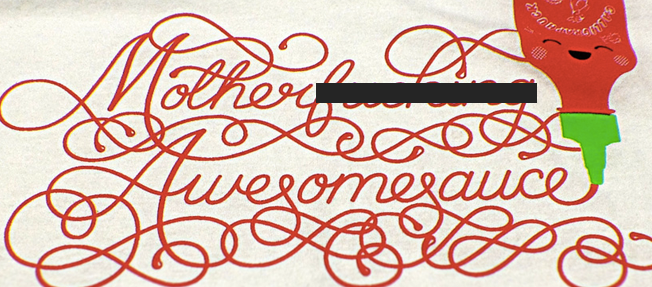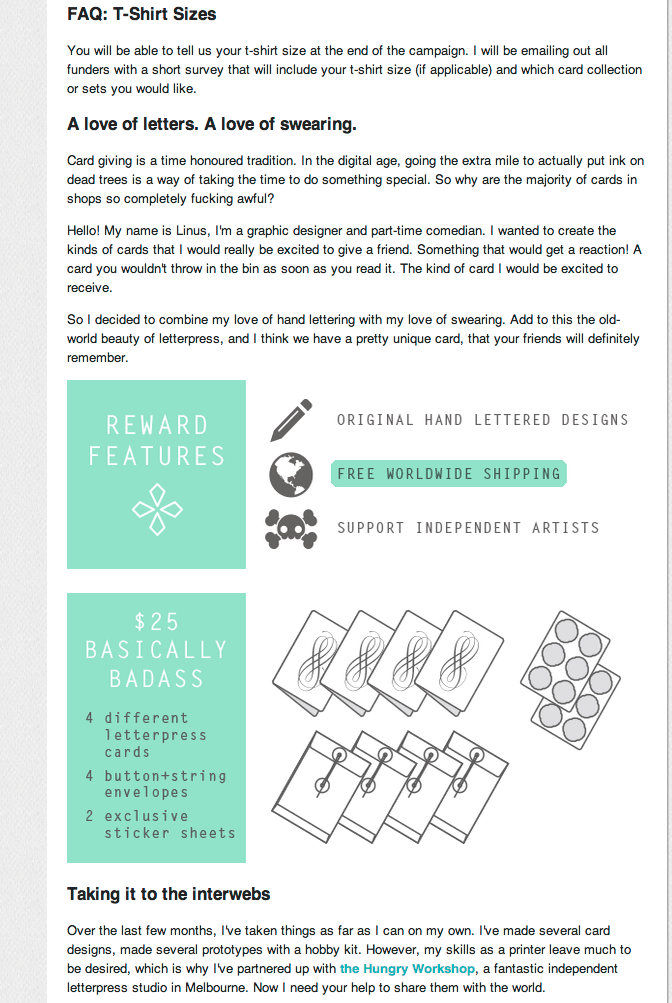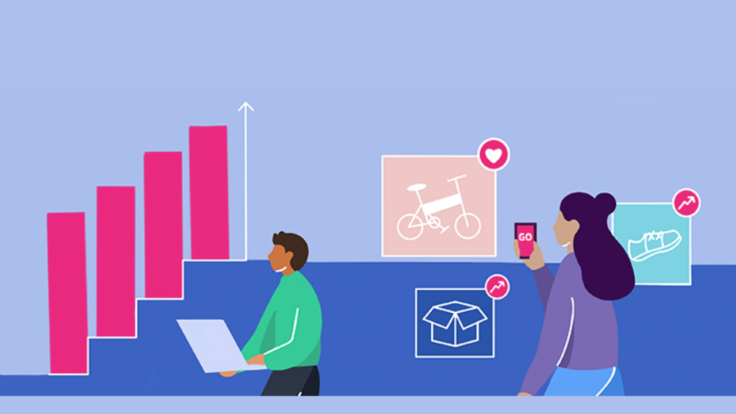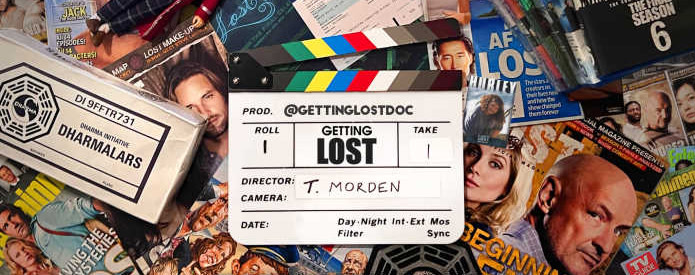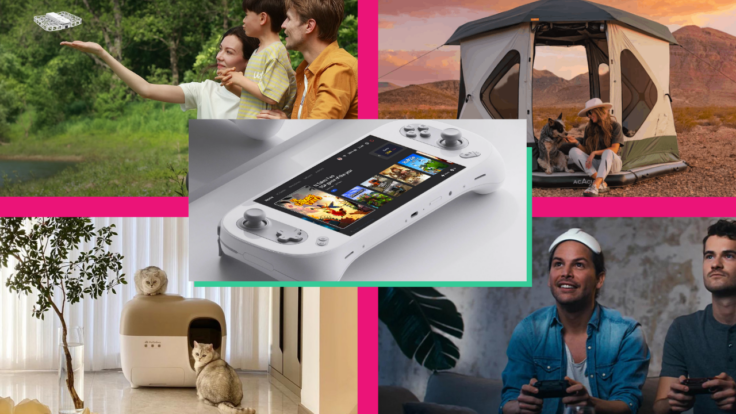Australia’s Linus Boman arrived at Indiegogo with a gift, an idea, a small following on Instagram — and a compendium of profanity. A little over a month later, he had raised over $12,000 — more than double his original goal of $5,000 — and brought his idea to life with the help of people all over the world.
Linus’ campaign, Calligraphuck: Exquisitely profane letterpress cards, is not only an example of a campaign with a great (and hilarious) idea — but also one with incredible execution. A closer look at it reveals a number of campaigner best practices for current and future crowdfunders:
Pitch Video (above) — Funny, but straightforward and engaging. Not only did Linus star in it, making it more personal, but he also clearly outlines the needs and goals of his project.
Campaign Page — Like the video, it’s funny, but easy to read and understand the core aspects of the campaign. It also includes great images of perks, a FAQ, and a section that tells people how to further spread the word.
Perks — Desirable, exclusive, and fairly priced. Additional perks were added later in the campaign to keep momentum up — and some perks had social media incentives to encourage sharing.
Updates — Linus sent a total of 11 updates — informing his contributors and newcomers to the campaign about everything from fundraising milestones to perk fulfillment. When his campaign reached its funding goal, he also updated his campaign page with “stretch goals.”
Perk Fulfillment — Linus was constantly transparent with his contributors to manage realistic expectations in terms of delivery dates and to update them on possible delays. He also sent a survey to contributors to collect important perk information like t-shirt sizes, using Fluid Surveys (Google Docs, Survey Monkey, and Wufoo also provide similar services). As a contributor myself, I have to say it was a great feeling to open an anonymous looking package and find my Calligraphuck perks inside!
(The highly popular and exclusive perk offered through the campaign.)

Getting stationery ready to send out!
Perks ready to be shipped!
Given the strength of his campaign, I knew that Linus would likely have great insights for current and future crowdfunders, and I got a chance to talk to Linus about his campaign and approach to crowdfunding:
Why did you decide to crowdfund?
I had an idea, and a knew how to execute it on a practical level, but I had no idea of what the demand would be. Crowdfunding was the perfect model, because it intrinsically linked with demand — not enough interest, not enough demand, the project would have been just a concept, and I would only have lost the initial time and money I put into design, prototypes and promotion, vs losing all of that and the cost of actual production. Thankfully there was a demand for it! Crowdfunding also made promotion easier, as something with a deadline always appears more urgent than something people can get at any time.
What factors went into choosing Indiegogo’s platform?
I liked that Indiegogo was a truly international platform. A lot of competitors restrict who can create a project, or fund a project, and Paypal, despite its shortcomings, is one of the most widely used and trusted online payment platforms, so that was a bonus too. Once I had started my campaign, the Indiegogo support team was also very helpful with advice and support.
What was a non-monetary benefit of your campaign?
The main benefit for me was connecting with such an awesome group of supporters around the world. If I had tried to raise the funds on my own, and gone a traditional small business route, I would never have reached as many people. To me there’s something very cool and very “2012” (without trying to sound like a complete wanker) about posting cards designed and printed in Australia to Norway, Croatia and Singapore from the UK, that were bought online in US dollars!
How did you promote your campaign?
I had been building a small following on instagram and tumblr leading up to the campaign, posting daily sketches (something I wish I still had time to do!) and I began by promoting the project to them, along with friends on facebook. I also contacted a few local publications and bought some ads on podcasts. Podcast advertising didn’t really work for me, likely because the project is so visual that it’s hard to explain in an audio-only format. Then once I had reached 30% of my goal, I went on a blog blitz. I had compiled a list of about 100 blogs which fit my criteria, and emailed them all. Probably about 10 got back to me, but amongst those 10 were some very high-traffic sites which helped enormously.
How did you go about fulfilling your perks?
I sent a survey out to all my contributors to get their choice of cards, t-shirt sizes and feedback. I wish I’d spent more time designing the survey, as many people forgot which perks they had chosen, and I had to chase a lot of people about something they had missed, but eventually I had a spreadsheet of everyone’s perks. By then I had moved to the UK, and was having the cards produced in Australia and the shirts produced in the US, so there were some logistics to work out with shipping costs, but finally, all the rewards were sent out.
How else are you following-up with your contributors?
When I sent out the survey, I added an option for people to join a mailing list, so I was able to offer Indiegogo supporters a special discount when I launched my online store. A number of people have got in touch since the campaign through facebook, twitter and instagram to tell me how much they love their perks, which always encouraging.
What’s your best piece of advice for future crowdfunders?
Be shameless in self promotion, but not to your fans.
I tried to make sure that my social media presence didn’t become just posts promoting the campaign, which was hard, especially the weeks when things were especially quiet. But whatever it was that made people follow you in the first place can’t disappear for the duration of your campaign.
On the other hand I had to email 100 blogs and tell them how great my project was, which made me feel like a real dick, but that’s self promotion and it’s a necessary part of the campaign. It may come down to personality type, but I find self promotion is very hard, and the amount of non-answers and flat out rejections can be really depressing. But when someone “gets it” and shares your project with their audience, it’s a wonderful feeling. And that exposure really is what will help you get over that funding goal!
What’s next for Calligraphuck?
Well, I’ve just launched my own store (https://calligraphuck.bigcartel.com/) as well as a new range of holiday cards.
Next on the agenda is to create some new shirts. The shirt perk was very popular, and I get people asking quite frequently if they can buy it now, but alas, it’s a limited edition, unique to Indiegogo! So I’m hoping to have some new designs next year, which I need to run the numbers on, but I may do a follow up campaign to get them off the ground!
Interested in crowdfunding? Get other great insights from our blog here!
